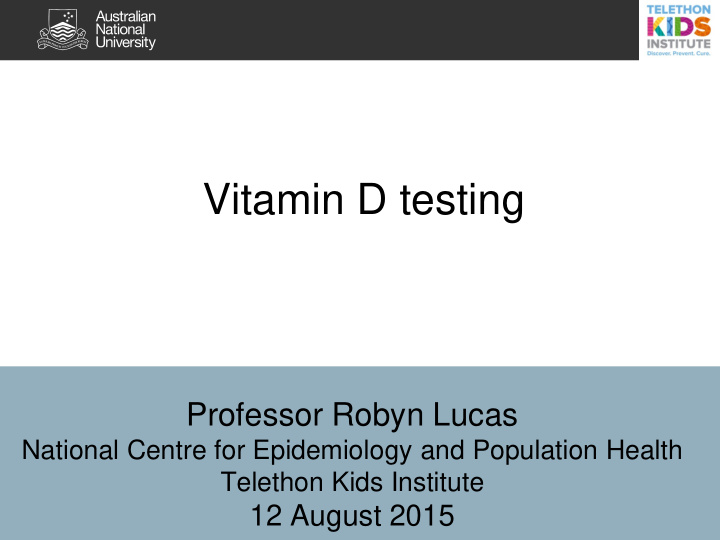



Vitamin D testing Professor Robyn Lucas National Centre for Epidemiology and Population Health Telethon Kids Institute 12 August 2015
Production of vitamin D 2
Why is vitamin D important? • Maintains calcium homeostasis – Increases Ca absorption in gut, reduces Ca loss in urine, if low Ca diet – resorption from bone − Severe vitamin D deficiency causes rickets in children and osteomalacia in adults 3
How much vitamin D is enough? Breast cancer risk Cardiovascular mortality Most of any protective effect occurs with levels ≥50nmol/L (i.e. little evidence for a need for very high levels) Peterlik. Food and Function 2012 4
5 QUESTIONS TO ASK YOUR DOCTOR BEFORE YOU GET ANY TEST, TREATMENT OR PROCEDURE 5
DO I REALLY NEED THIS TEST OR PROCEDURE? • Vitamin D insufficiency has been linked with increased risk of a wide range of diseases BUT • It is not clear that this is a causal association • Convincing evidence that risk of rickets and osteomalacia is increased with severe vitamin D deficiency (<30nmol/L) What is the probability of the patient having severe vitamin D deficiency? 6
Vitamin D status of adult Australians Proportion in different categories of 25(OH)D level (nmol/L) 20.0 6.5% <30nmol/L 18.0 7.0%>100nmol/L 16.0 14.0 12.0 10.0 8.0 6.0 4.0 2.0 0.0 ≥130 <20 20 to 30 to 40 to 50 to 60 to 70 to 80 to 90 to < 100 to 110 to 120 to <30 <40 <50 <60 <70 <80 <90 100 <110 <120 <130 Male Female 7 Australian Health Survey, Biomedical results, 2011-12
Australian Health Survey Vitamin D deficiency (<50nmol/L) by state and territory, 2011-12 Summer Winter 8
Australian resident population: Vitamin D deficiency by region of birth, 2011-12 9
Medicare guidelines for vitamin D testing • Limited sun exposure due to skin pigmentation • Limited sun exposure due to sun avoidance, including residential care, or other occupational, medical or cultural reasons • Signs or symptoms of osteoporosis or osteomalacia • Isolated increased in alkaline phosphatase (ALP) on liver function tests • Hyperparathyroidism, low serum phosphate or abnormal serum calcium • Patients with malabsorption, e.g. cystic fibrosis, short bowel disease etc • Use of anticonvulsants and other medications known to lower vitamin D levels • Chronic renal failure or renal transplant recipients • Children under 16 yrs with signs or symptoms of rickets • Infants whose mother has established vitamin D deficiency • Patients with a sibling under 16 yrs with vitamin D deficiency. 10
WHAT ARE THE RISKS (of vitamin D testing)? • Will there be side effects? • What are the chances of getting results that aren’t accurate? • Could that lead to unnecessary or inappropriate treatment? 11
DEQAS sample 417 (July 2012) ALTM 47.1 nmol/L Results sorted in ascending order: range from <20 to >100 Slide courtesy of Dr Graham Carter
Variation in vitamin D assays Binkley et al. Clin Chim Acta. 2010;411:1976-82 13
Misclassification of vitamin D status by assay…. 100% 90% 80% 70% ≥75 nmol/L 60% 50-74 nmol/L 50% 30-49 nmol/L 13-29 nmol/L 40% <13 nmol/L 30% 20% 10% 0% Certified laboratory* Laboratory A Laboratory B Laboratory C Lab A=LCMS/MS; Lab B=LCMS/MS; Lab C=immunoassay 14
Benefits of vitamin D supplementation • Benefits for severe deficiency BUT • No consistent evidence that vitamin D supplementation decreases disease risks except to treat severe vitamin D deficiency (rickets, osteomalacia, falls) 15
Vitamin D and disease - Is more always better? Hazard ratios for cardiovascular disease mortality in relation to 25(OH)D level 3 Odds of prostate cancer 1 in relation to serum 25(OH)D level Mortality rate adjusted for age, sex, race/ethnicity and season by 25(OH)D concentration. 15-year follow-up of NHANES III (n=15 099) 3 1.Tuohimaa et al Int J Cancer 2004; 2. Sempos Am J Clin Nutr2013; 3. Durup et al JCEM 2015 16
ARE THERE SIMPLER, SAFER OPTIONS? • Most vitamin D is UV-induced UVR UVA + UVB PGE2 α -MSH Others, e.g DNA Cis- Vitamin Nitric cytokines damage UCA D oxide Skin cancers 17
Is sun exposure a “safer” method to vitamin D sufficiency than supplementation? • Australia has the highest skin cancer incidence in the world • Possible non-vitamin D benefits of sun exposure • Is there a safe pattern of sun exposure that still allows vitamin D production? Fig 2. Melanoma incidence (blue) & mortality (red), 2012 18
WHAT HAPPENS IF I DON’T DO ANYTHING? Will my condition get worse — or better — if I don’t have the test right away? • Ask about sun exposure to the skin • Is a behaviour change possible/likely? • Think about location and season (many people will be mildly insufficient in late winter, but it will get better in summer) 19
Brisbane Sun exposure and vitamin D 10 20 25(OH)D nmol/l 0 -20 -10 • Low UVR: southern location, winter 0 3 6 9 12 Month • Low time outdoors Newcastle 10 20 25(OH)D nmol/l • Little skin exposed when outdoors 0 -20 -10 • Dark skin 0 3 6 9 12 Month Geelong 10 20 140 25(OH)D nmol/l 0 25(OH)D (nmol/L) -20 -10 120 0 3 6 9 12 Month 100 Tasmania 10 20 25(OH)D nmol/l 80 0 -20 -10 60 5 10 15 20 25 30 0 3 6 9 12 Weekly hours in the sun Month Variation in seasonal pattern Variation in 25(OH)D level with time outdoors according to latitude 20 Lucas et al. J Steroid Biochem 2013;136:300-8
WHAT ARE THE COSTS? Medicare services per capita, 2000-14 20000 18000 16000 Vitamin D services per 100,000 14000 12000 10000 8000 6000 4000 2000 0 Year Increase in costs: from $1.02 million in 2000 to >$145 million in 2013 (down to $124 million in 2014) 21
22
Recommend
More recommend